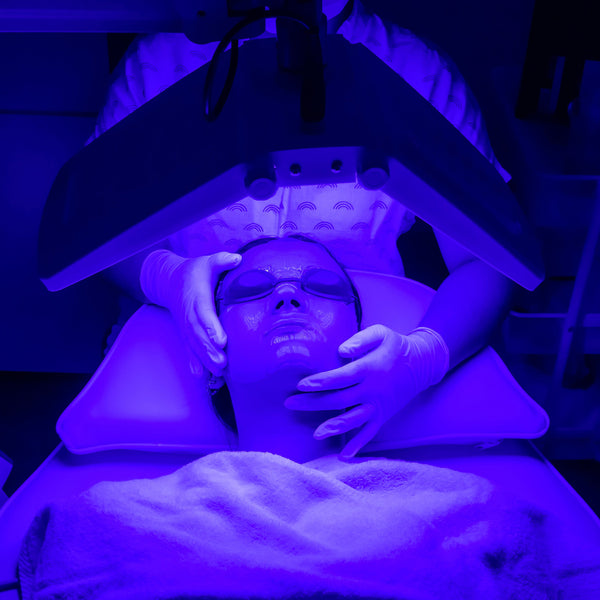Peptides – the indispensable antiaging ingredients of 2023

There is a lot of buzz about peptides and their antiaging and regenerative effects on our skin and hair. There is no denying that peptides have become the go-to ingredient of the last two decades. In addition, the growing information about their reparative use has augmented the demand for synthetic peptides for esthetic use.
Did you know that our bodies make peptides? They are found in every cell and tissue and perform various essential antioxidative, antiaging, reparative, and anti-inflammatory functions. "What are peptides?" you may ask. Peptides are often confused with proteins but are indeed the building blocks of proteins such as collagen, elastin, and keratin. Peptides are short polymers formed by linking amino acids, which act as foundations of the skin and are responsible for its texture, elasticity, tone, and resilience. Not all peptides form proteins, but all proteins consist of peptides.
A Brief History of Peptides
The first peptide was synthesized in 1882 in Leipzig, Germany, by then at 25-year-old chemist Theodore Curtius. The word "peptide" was later coined by 1902 Nobel Prize-winning German chemist Emil Fischer from the Greek "Pepsis" = digestion. Between 1899 and 1908, Fischer contributed to the knowledge of proteins and sugars. He introduced the term "peptide" and his research in separating and identifying the individual types of amino acids at the 14th meeting of German scientists and physicians on September 22, 1902, at Karlsbad. Fischer's Nobel prize, however, was not awarded to him for his work with peptides but in recognition of his groundbreaking research on the sugar and purine groups of substances.
Fischer studied the synthesis of proteins by obtaining the various amino acids in an optically active form to unite them. He suggested that the amino acids in proteins are linked together by amide bonds, or "peptide bonds." Fischer established the type of bond connecting them in chains, namely, the peptide bond. Employing this, he obtained the dipeptides and later the tripeptides and polypeptides.
In collaboration with Ernest Fourneau, Fischer synthesized the first free dipeptide, glycylglycine. His synthesis of the oligopeptides resulted in an octadecapeptide, which had numerous traits of natural proteins. There is no doubt that Fischer's groundwork laid the foundations for later peptide research.
What Is the Function of Peptides?
Peptides are short chains of two or more amino acids (the fundamental molecules that serve as the building blocks for proteins). Peptide bonds link together multiple amino acids within a protein, creating a chain; these bonds are considered covalent amide bonds because they are formed by equal sharing of electrons from both atoms. When applied topically, peptides act as messengers, triggering skin cells to perform specific functions such as building collagen and elastin and helping improve wrinkle depth and volume. In addition, when used in synergy with other nourishing ingredients, peptides may help repair the skin's barrier functions and improve hyperpigmentation, erythema, dryness, and desquamation.
The prefixes we often see on product ingredient decks - di-, tri-, etc., indicate the number of amino acid units from which the particular chain is made. A peptide comprised of two amino acid residues is called a dipeptide, one made from three is a tripeptide, and one made from four is a tetrapeptide. A polypeptide is formed when the chain of amino acid residues exceeds several dozen in length. A protein is composed of one or more polypeptide chains. Most of the skincare products we know and love display peptides in their ingredient list under their INCI names and may include the registered name in parenthesis.
INCI names (International Nomenclature Cosmetic Ingredient) are internationally recognized systematic names that identify cosmetic ingredients – a uniform system of labeling cosmetic ingredients. For example – one of my favorite antiaging peptides – Matrixyl®3000, appears on product labels as Glycerin (and) Water (and) Butylene Glycol (and) Carbomer (and) Polysorbate 20 (and) Palmitoyl Tripeptide-1 (and) Palmitoyl Tetrapeptide-7.
Peptides in Skincare
Peptides entered the cosmeceutical field in 1973 when the synthetic copper peptide GHK-cu (glycyl-l-histidyl-l-lysine ) was discovered by Dr. Loren Pickart as a signal peptide augmenting collagen production. Most commonly, the peptides used in cosmetic formulas are sourced from cotton, wheat, rice, casein, and whey and synthesized in a lab.
Cosmeceutical peptides can be divided into four main groups:
Signal Peptides
Carrier Peptides
Enzyme Inhibitors
Enzyme-inhibiting peptides prevent collagen breakdown and degeneration.
Neurotransmitter Inhibitors
Neurotransmitter inhibitors hinder muscle contraction and inhibit the production of Acetylcholine, which blocks the impulse in the neuromuscular junction. This creates a "Botox-like" effect, but instead of paralyzing the muscles, they relax the tension of the facial skin's mimetic muscles, which prevents the formation of new expression lines and softens the depth of the existing ones.
Peptides Worth Trying in 2023
Launched in 2001 after 10 years of research, Argireline ® (acetyl hexapeptide 3 / acetyl hexapeptide 8) is perhaps the most well-known type of neurotransmitter inhibitor peptide on the esthetic market. It is a synthetic hexapeptide designed to mimic Botulinum Toxin and formulated especially for expression lines and the delicate eye area. According to the manufacturer of the ingredient, Lipotec: “Argireline ® reduces the depth of wrinkles on the face caused by the contraction of muscles of facial expression, especially in the forehead and around the eyes. It is a safer, cheaper, and milder alternative to Botulinum Toxin, topically targeting the same wrinkle-formation mechanism in a very different way.” In in-vivo trials, a significant reduction in wrinkles was absorbed after 30 days of using a 10% Argireline® solution.
Leuphasyl (Pentapeptide-18) as its name suggests is a synthetic peptide composed of five amino acids. Its manufacturer claims that this neurotransmitter inhibitor peptide and when used in synergy with Argireline®, may reduce the appearance of wrinkles by up to 50% if used twice daily. Just like Argireline®, Leuphasyl is recommended at a 5%-10% concentration in cosmetic formulations.
SYN®-AKE (Dipeptide diaminobutyroyl benzylamide diacetate) is a vegan dipeptide that mimics the functionality of Waglerin-1 - a peptide found in the venom of the temple viper, Tropidolaemus wagleri - so the name, SYN®-AKE isn’t just a coincidence. This synthetic version of Waglerin – 1 is named so for its ability to inhibit muscle contractions and is recommended to use on expression lines, per manufacturer. In-vivo trials on different age groups suggest that SYN®-AKE can: Visibly reduces deep wrinkles by up to 20% in just 4 weeks, and help delay the appearance of wrinkles.
SNAP-8™(Acetyl Glutamyl Heptapeptide-1)( Aqua (and) Acetyl Octapeptide-3 (and) Caprylyl Glycol) contains an anti-wrinkle octapeptide that is an elongation of the hexapeptide Argireline ®. According to Lipotec, the manufacturer, SNAP-8™ operates as an inhibitor of muscle contractions, and its efficacy is about 30% higher than the efficacy of its parent peptide Argireline®; as confirmed in vivo and in vitro tests. A 10% SNAP-8™ solution was responsible for 63.18% visible reduction in wrinkles over a 28-day period.
Launched in 2000 by Sederma, Matrixyl®3000 (Glycerin (and) Water (and) Butylene Glycol (and) Carbomer (and) Polysorbate 20 (and) Palmitoyl Tripeptide-1 (and) Palmitoyl Tetrapeptide-7) is the first groundbreaking extracellular matrix-derived peptide. This combination of Palmitoyl Tripeptide and Palmitoyl Tetrapeptide is a Signal Peptide stimulating collagen, hyaluronic acid, and elastin production, which in turn, helps improve skin elasticity, density, and thickness. In-vivo trials at a 3% use level show a 20% reduction in wrinkle depth and volume, 10% wrinkle depth reduction, 30% reduction in wrinkle density, and dermal structural improvement with confocal microscopy imaging when used for 2 months twice daily.
Melanostatine® 5(Water (and) Butylene Glycol (and) Dextran (and) Nonapeptide-1) produced by Lucas Meyer, is a biomimetic oligopeptide that inhibits melanin synthesis by preventing activation of the tyrosinase, without interfering with the melanocyte’s functions. It’s the non-toxic ingredient of choice for skin brightening for hyperpigmented skin including skin affected by melasma and sunspots. The recommended dosage is 4%-8% for skin-brightening formulations.
While most of today's trending peptides have good efficacy and safety profiles, the permeation through the skin can be poor. With a high molecular weight (above 500 Daltons), most peptides require a little help from a proper carrier system, but many ultimately end up sitting on the skin. With that said, the best products with peptides are serums and creams. In addition, iontophoresis and sonophoresis have both been shown to increase the absorption of products containing peptides and are excellent tools to have in the treatment room. LED light, has also been shown to work in synergy with peptide products, delivering both antiaging and reparative benefits.










